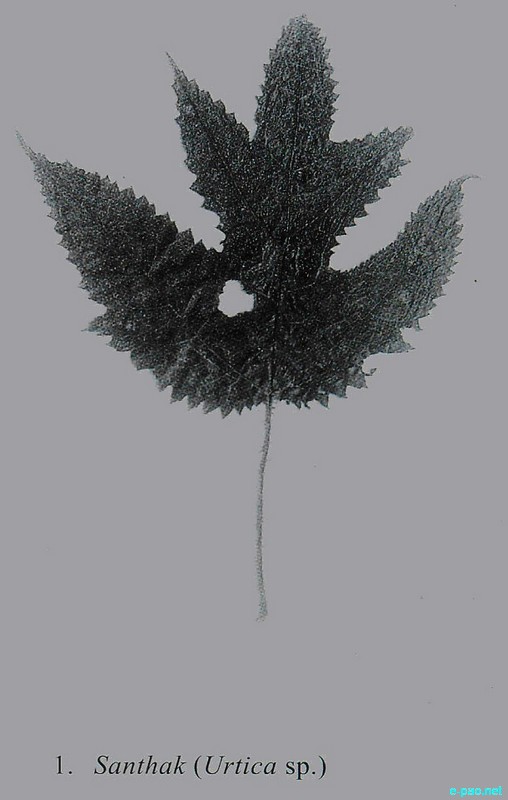Tribal hand woven fabrics of Manipur
- Part 1 -
By: Mutua Bahadur *
HISTORY
Since remote past, in the tribal societies of Manipur, womenfolk have been weaving cloths needed only for their own use in loin looms. In addition to the use of loin loom, the Meiteis in the valley introduced the use of throw shuttle looms in the eleventh century. By 1900, the valley people have become adept at weaving in fly shuttle looms.
Yet, the tribal weavers mostly use the loin looms because they still do not possess the knowledge of other weaving methods. Nevertheless, some sections of the tribes have acquired the art of weaving by using the fly shuttle loom. It had been introduced by the year 1983 at some cooperative societies in some areas of Churachandpur District with the financial assistance from the Government.
Most of the tribal textiles have colourful weft woven designs. They also weave extra warp designs which are of two kinds : (a) Decorative and (b) Ordinary. Various designs are tessellated in geometrical forms. But most of the designs are interpreted as realistic portrayals by the natives. There are designs symbolising animal bones, creatures, animals, fishes, birds, etc. Tribal textiles bear not only the woven designs but also additional decorative objects.
For example, Changkha enhii, a petticoat of the Monsang worn while dancing, is decorated with at least three small metal bells. However, the bells are the products of the Meitei artisans. Cowries are also used in decorating cloths by some tribes of Manipur. Interlacing of the designs and applying of decorations consume much time. In addition, a cloth is the combination of some sutured pieces as the loin loom products are usually very short in breadth.
There is no specific weaving site for the loin loom and the weavers can weave anywhere, whether it may be in the veranda or inside the house or any open site. They carry weaving tools and implements if they happen to migrate or move temporarily to any place. They can set up the loom wherever they are.
The tribal people weave using the natural fibres and cotton is the most widely used raw material. Even though the Meiteis did use silk from early times, the hill people still cannot involve the silk yarn in their weaving craft. At some houses of weavers inhabiting the northern hills of Manipur and belonging to the Mao, the Maram and the Poumai, they are still extracting fibres from the barks of Santhak (Urtica sp.) and other plants to weave ethnic cloths. But the weavers of the northern region are also experts at weaving from cotton fibres.
Around 1950, the staple yarn was imported into Manipur and the tribal people began to use it as well. During 1960-70, four-ply acrylic wool was brought in. These four-ply wool were split laboriously into one- or two-ply wool for weaving. Then, around 1980, one- and two-ply wool was introduced and the hill people also began to use these wool yarns to weave cloths conveniently in assorted colours.
From early times, the tribal folk used natural colorants that were extracted from the leaves and plants found in the locality to make vegetable dye. Black is the dominant colour in their textiles but red and yellow colours are not ignored.
Though the cloths are differentiated as heterosexual possessions, there are some tribal societies in which the same cloths are used by both sexes.
The tribal folk wove only for their domestic use and not for the market. In buying a cloth from a tribe one faces such problems as high price and unavailability of the desired cloth at any time. So, the buyer has to wait patiently to procure the high priced cloths. This induces an increase in the use of Meitei products, which can be obtained at short notice and at low cost.
The heavy expense and the time consumed adversely affect the commercial production of the tribal textiles. But in some regions of the Churachandpur District, the weavers began to use the fly shuttle loom and produce cloths commercially. They are not only advanced in this craft but also apply the aesthetic values of their traditional cloths in different ways. At present they make cloths with indigenous designs which are awarded to men of dignity such as those who have achieved high education from colleges and universities. The cloth is given the name as B.A. Puandum.
Changes in textile pattern of the tribes of Manipur are observed distinctly when the present-day cloths are compared with those of ten years ago. Another interesting feature is the application of needle works in the tribal textiles. In the past, the tribal weavers did not have the skill in needle works. But nowadays, some embroidered textiles are produced by the tribal people. Imitating the Sami-Lanmi cloth produced especially by the Meitei for the tribal people, weavers at Kasom Khullel in Ukhrul District and Mao village in Senapati District also produce needle worked cloths.
An interesting feature regarding the tribal textiles is in possessive interpretation of the designs. Cloths with similar patterns are claimed by different tribes as their own, supported by their respective prevalent myths. The same design is interpreted differently by different tribes, connecting their creations to their oral traditions.
MATERIAL
The tribes in Manipur grew cotton in swidden fields. They could pick cotton enough to weave their essential cloths. The use of cotton fibre among the tribes had been reported from the early days of their settlement. Since the reign of King Khagemba (1597-1652 A.D.), some tribes such as the Tangkhul, the Kabui, the Maring, the Thangal, the Makhan, etc. paid at least a Pon-ful of cotton as annual tribute to the Meitei King.
In the 1950s, the staple yarn was imported from outside Manipur. After using the cloth of staple yarn for some years, its use became unpopular because of its heaviness in wearing. In the 1960s and 1970s, the tribal weavers came to use the four-ply acrylic wool. But they split the four-ply

to one- or two-ply wool in their weaving. Then, around the 1980s, one- and two-ply wool yarns were used in the hills of Manipur. One- or two-ply wool became the most suitable yarn for tribal weaving. This is because of its warmness, cheap price and availability in different colours at any time in the market. In addition, the weavers can achieve quick accomplishment of their work. Above all this, they were free from the hard and poor method of vegetable dye.
Even today, at some houses of the tribes such as the Mao, the Maram and the Poumai who are inhabiting the northern hills of Manipur, they extract thread from the stalk of Santhak (Urtica sp.) (Fig. 1) which is known locally to the Mao as Shiingolo or to the Poumai as Nuluilousa. The use of Santhak fibre in weaving is also found among the Chakesang tribes of Nagaland. The fibrous barks of the plant known as Dolousa to the Poumai or Madelosa to the Mao and the creeper locally known as Shailousa to the Poumai or Kokhriisa to the Mao are also used to turn out threads. The Poumai also use to extract the natural fibre from the plant known by them as Khoilousa. The bark of this plant is gathered in June and well dried. Then it is soaked in water. Afterwards it is split and twisted on the thigh of the weavers.
The Tarao, inhabiting the southern parts of Manipur, use to extract fibre from the bark of Sougri which is known to them as Bulathin. The bark of Bulathin is put in water and boiled and then dried in the sun. This is followed by splitting into fibres with the help of an Unio shell. The cloth made of this thread is called Bulapun.
See a gallery photo of Tribal hand woven fabrics of Manipur here.
To be continued ....
|
* Mutua Bahadur contributes to e-pao.net regularly. This article was webcasted on July 28, 2012.
* Comments posted by users in this discussion thread and other parts of this site are opinions of the individuals posting them (whose user ID is displayed alongside) and not the views of e-pao.net. We strongly recommend that users exercise responsibility, sensitivity and caution over language while writing your opinions which will be seen and read by other users. Please read a complete Guideline on using comments on this website.









